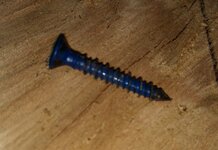FGarbrecht
Member
I'm trying to teach myself some basic bowlturning and have run into a couple of problems. [My first bowl went surprisingly well, and my wife wouldn't let me add this first effort to the firewood pile. She insisted I put a finish on it and give it to someone as a gift, so my daughter is getting a bowl for Christmas].
Problem #1: one of the screws I used to attach the faceplate sheared off into the wood as I was attaching it. I turned the outside of the piece anyway, figuring that the bowl blank was pretty balanced and not very heavy so the remaining screws would hold just fine, and they have. Now I'm nearly ready to hollow out the inside and I've got to remove the screw. (It's a small faceplate so the screw is located in an area of wood that is going to be removed when I hollow the inside). I figured I would just have to use a chisel and hammer to get it out, but if anyone has better suggestion(s) I'd be interested. And yes, I already heard not to use sheetrock screws, and I won't ever do it again, I've learned my lesson.
Problem #2: I'm trying to finish the outside of the bowl before turning it around to hollow it on the lathe, and the sanding isn't going great. On the opposite sides of the blank (this is a piece of Padauk), where the end grain comes out it seems impossible to get a smooth finish. I've tried used Abranet (by hand on the lathe) - 240, 320, 400, 600. I've also tried power sanding with a rotary setup on the spinning lathe. Am I just not being patient enough? I just put on a coat of Mylands sanding sealer hoping to close the problematic end grain. Any suggestions here? I've seen some you-tube videos about basic bowl work and they sometimes use abrasive paste products for polishing after the initial sanding; is this necessary and/or desirable? Any products you recommend?
Problem #1: one of the screws I used to attach the faceplate sheared off into the wood as I was attaching it. I turned the outside of the piece anyway, figuring that the bowl blank was pretty balanced and not very heavy so the remaining screws would hold just fine, and they have. Now I'm nearly ready to hollow out the inside and I've got to remove the screw. (It's a small faceplate so the screw is located in an area of wood that is going to be removed when I hollow the inside). I figured I would just have to use a chisel and hammer to get it out, but if anyone has better suggestion(s) I'd be interested. And yes, I already heard not to use sheetrock screws, and I won't ever do it again, I've learned my lesson.
Problem #2: I'm trying to finish the outside of the bowl before turning it around to hollow it on the lathe, and the sanding isn't going great. On the opposite sides of the blank (this is a piece of Padauk), where the end grain comes out it seems impossible to get a smooth finish. I've tried used Abranet (by hand on the lathe) - 240, 320, 400, 600. I've also tried power sanding with a rotary setup on the spinning lathe. Am I just not being patient enough? I just put on a coat of Mylands sanding sealer hoping to close the problematic end grain. Any suggestions here? I've seen some you-tube videos about basic bowl work and they sometimes use abrasive paste products for polishing after the initial sanding; is this necessary and/or desirable? Any products you recommend?

